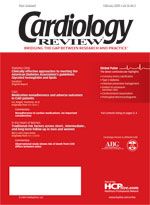A case of disease progression or nonadherence?
A 66-year-old man with a history of coronary heart disease, hypertension, type 2 diabetes mellitus, and hyperlipidemia presented to the clinic for follow-up after recent hospitalization for unstable angina.
A 66-year-old man with a history of coronary heart disease, hypertension, type 2 diabetes mellitus, and hyperlipidemia presented to the clinic for follow-up after recent hospitalization for unstable angina. His symptoms prior to hospitalization included progressive dyspnea on exertion during his daily walks. During hospitalization, he had undergone percutaneous coronary intervention of the first obtuse marginal branch without complications. On admission, his glycosylated hemoglobin (A1C) level was 6%, and his low-density lipoprotein (LDL) cholesterol level was 78 mg/dL. His blood pressure during hospitalization was consistently around 120/60 mm Hg. He was discharged with prescriptions for atenolol (Tenormin) 100 mg once daily, glyburide (Diabeta, Glynase, Micronase) 2.5 mg twice daily, and simvastatin (Zocor) 40 mg once daily.
Three months after discharge, the patient was doing well and was able to walk 1 mile daily without symptoms. He stated that this was the best he had felt in a long time. His blood pressure was 158/84 mm Hg, and his nonfasting glucose level with a fingerstick was 137 mg/dL. Results of his cardiovascular examination were normal. His A1C level was 8.9%, and his LDL cholesterol level was 148 mg/dL. He stated that he was still taking the same medications as at the time of discharge several months earlier. Given the patient’s elevated blood pressure, A1C level, and LDL cholesterol level, his medication was adjusted. Hydrochlorothiazide (HydroDIURIL, Esidrix, Oretic) 25 mg once daily was added. The dose of glyburide was doubled to 5 mg twice daily, and the simvastatin was switched to atorvastatin (Lipitor) 80 mg once daily. The patient was instructed to return in 4 to 6 weeks for follow-up blood pressure measurements and blood tests.
The progression of underlying disease might explain the elevated blood pressure, LDL cholesterol level, and A1C level during the follow-up clinic visit; however, adherence to medications should also have been assessed. Because the patient was asymptomatic and feeling well after his recent coronary intervention, he may not have been taking his medications routinely. This case report illustrates a common clinical scenario, in which medications are often adjusted to achieve guideline-recommended targets. However, given that medication nonadherence is common in clinical practice, nonadherence assessment should be part of the differential diagnosis when a patient is not responding to therapies that have been previously effective. Evaluation of medication adherence is also critical for all patients who do not seem to respond to intensification of therapies because this may be a sign of nonadherence rather than nonresponse to medications.
